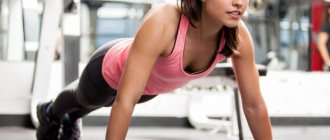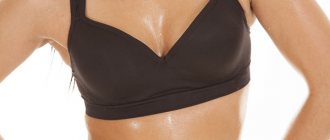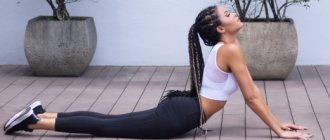The plank is a static exercise aimed at strengthening the shoulders and lumbar region of the athlete. To implement the training, you need to prepare a flat surface on the floor.
Included in a set of warm-up actions, as exercises or exercises in the gym.
The regularity of performing the plank exercise for men allows you to achieve a general health effect and speed up the process of drying the body.
Benefits of the plank
The effectiveness of plank execution by young athletes is not appreciated. However, when implementing classes on an ongoing basis, changes are noticeable within a month.
The exercise is added to fitness classes, yoga, and bodybuilding.
The benefits of the Plank exercise for men are:
- strengthening the abdominal muscles, buttocks, lower back, shoulders;
- relieving pain in the spine;
- creating beautiful posture;
- acceleration of the metabolic process (during exercise there is an increase in metabolism);
- increasing the level of flexibility;
- reducing the risk of injury to the back and spine;
- improving mood and reducing stress;
- a set of plank exercises for men leads to increased endurance of the body.
Classes in a static version allow the stronger sex to achieve drying of the body in an accelerated time.
Benefits of exercise
By doing the plank regularly, you can achieve:
- muscle strengthening
The plank gives a good load on the abdominal muscles, both oblique and rectus, and also makes the buttocks work.
- reducing pain in the spine and beautiful posture
The main advantage of this exercise is that it trains the spinal muscles without overstraining the spine itself, so you can do the plank even with minor problems with the spinal discs. The exercise also strengthens the abdomen, the muscles of which help support the back in the desired position.
- acceleration of metabolism
Speeding up your metabolism is especially important for overweight men, but it will also be useful for others.
- flexibility
While performing the plank, the posterior muscles of the legs and back are stretched.
Contraindications to performing the plank
There are a number of contraindications to performing the plank. It is prohibited to conduct static type classes if:
- hernia diagnosed;
- there is a spinal injury;
- increased blood pressure;
- presence of ligament or tendon injuries;
- inflammatory process;
- chronic pathology in an acute form.
What benefits does the “Plank” exercise give to men with regular violations?
Firstly, the risk of injury increases significantly. Secondly, starting sports without consulting your doctor is prohibited. Loads will lead to negative consequences.
Watch your back!
For any exercise, even the most useful one, there will always be people who should stay away from it. The plank is contraindicated for a number of diseases.
1. First of all, these are any injuries to the back and neck: bruises, fractures, intervertebral hernias, pinched nerves.
Sore joints are the second to be hit , since they will have to take on a significant load.
3. Although to a lesser extent, internal organs are still at risk. The efforts that an athlete has to put in indirectly affect them and if, say, the pancreas or liver is already affected by some kind of ailment, the bar will aggravate it.
Plank techniques
There are several types of Plank exercises for men. The technique for performing them is different.
Let's look at the classic variation:
- Take the position on the floor “Lying support”, standing on your elbows and toes.
- Keep your back straight, trying not to bend.
- The elbows are located under the shoulder girdle.
- The head is at the level of the spine.
- The pelvis is level with the back - do not lift up.
- The leg muscles are tense, stretched to their maximum.
- Breathe slowly, evenly.
In the photo, the plank exercise for men is done correctly for clarity.
What muscles work
Doing the plank involves muscle tension, but completely eliminates any bodily movements. As a result, the group of muscles involved in the static load immovably holds the body and its own weight. At the same time, in 10–20 minutes of standing, the whole body is worked out.
In particular, the following muscles are strongly tensed:
- gluteus maximus;
- legs (calf and front surface of the thighs);
- cervical;
- dorsal;
- upper shoulder girdle group;
- abs (including obliques);
- biceps;
- triceps.
Important! If you feel a burning sensation after doing the plank, the workout was effective.
Side plank
There is a well-known type of exercise for advanced athletes - a lateral version. Used as an additional exercise.
The execution technique is as follows:
- Lie sideways on a flat surface, lean on your lower elbow.
- From above, the hand is located along the body. It is allowed to rest against the thigh.
- We align the line of the body by stretching the legs horizontally and parallel.
- Keep your back straight, your whole body elongated and tense. The pelvic part is raised above the floor and the abs are tense.
In the video, the “Plank” exercise for men demonstrates the correctness of the exercise. The consequence is the development of the muscular skeleton of the forearms, abdomen, and buttocks.
What are the standards?
There are no strictly established standards for the plank, but the approximate norm for young men is 60-120 seconds, and the latter result for any age is an indicator of good physical fitness, this is the indicator to which one should strive.
As an example, let's remember the record holders. The latest world record for holding a plank on the elbows belongs to George Hood - 8 hours 15 minutes. And the man did this at 62 years old.
Advanced plank
The maximum effect is achieved by the plank in a complicated version. To implement it, the basic position of the lateral version of the exercise is performed.
The following technique is followed:
- The upper leg is raised parallel to the lower leg and held suspended at a level just above the head.
- The arm extends straight up.
- The reference points are the left parts of the body.
- The gaze is directed forward.
The Plank exercise for 30 days for men can be performed in various variations.
Recommendations and tips
At the end of the story, I would like to give some advice and recommendations to ensure that your efforts are as effective as possible:
- To increase the load, the feet must be connected.
- Keep your abs and buttocks tight throughout the plank.
- The lower back should not bend.
- The head and neck are in line with the entire body.
- Do not squeeze your shoulder blades.
- The plank is an exercise that can be done every day.
- The optimal number of approaches is 4 for 30-60 seconds with a rest interval of about half a minute, no more.
If you are a beginner, then start your workouts by holding the exercise for 15 seconds, but not staying long at this time, but gradually increasing it (based on how you feel).
You should not start exercising immediately after eating - it is reasonable to wait 1.5-2 hours (if the food was not too heavy)
After the load, also sit down at the table after the same period of time, which is very important for those who want to lose weight
Having mastered the technique of performing the plank, all that remains is to make your workouts regular, adjust your diet and enjoy the positive changes in your body and health, leaving positive feedback.
Elevated Leg Plank
You can complicate the classic static-type stance by using a raised leg. This approach loads the muscles as much as possible. For this:
- Basic stand on a flat surface.
- One leg rises up, reaching the level of the crown and slightly higher.
- The toe is extended as much as possible.
- The muscles are tense and the leg is straight.
- Later you change legs.
What else can you do to lose weight faster?
Aerobic exercise
Doing aerobic exercise (cardio) is a great way to burn calories and improve your physical and mental health. Cardio is especially effective at removing belly fat, the unhealthy fat that accumulates around organs and causes disease.
Strength training
This will speed up your metabolism and prevent you from losing muscle mass.
Of course, it is important not only to lose fat, but also to gain muscle. Therefore, strength exercises are necessary
High Intensity Interval Training
Without spending a lot of time on exercise, you will speed up your metabolism, increase endurance, and burn additional calories.
Knee plank
There are reviews online about the plank exercise for men, performed on the knees. It is believed that the lesson option is suitable for future jocks and athletes.
The technique is to take a “dog” pose (on all fours). The emphasis is on the knees. It is allowed to straighten your elbows or leave them in a bent position.
It takes 2 minutes to hold the pose. Having achieved a positive result, you can move on to the classic version.
What does exercise do for a man?
All software packages aimed at creating a beautiful, toned body include this exercise. Its popularity has contributed to the emergence of many myths about the ease of implementation and the exaggerated effect of the training. Therefore, from the very beginning we will clearly distinguish between reality and fiction.
Benefit
Many trainers recommend a 10-minute stand in one of the plank variations to tone the muscle corset. You shouldn’t believe that this exercise will develop all the abs on your stomach in a few days or help you get rid of extra pounds. But at the same time, its result cannot be underestimated.
And it consists of this:
- The training helps develop willpower, because being motionless in the same position while holding your own weight is very difficult.
- During the training process, the main muscle groups of the body are involved. Prolonged static tension helps to strengthen them, which, together with proper nutrition and other types of physical activity, is the basis for creating body relief.
- The plank helps to painlessly develop the muscle group of the back in case of displaced spinal discs and various injuries. It is also an effective preventative against osteochondrosis and degenerative osteoarthritis.
- Forms correct posture. With regular exercise, stooping is eliminated. Moreover, men who stand for 10–20 minutes every day continue to keep their back straight even outside of training time.
- Helps develop body flexibility.
- Stimulates metabolic processes.
- Helps get rid of psycho-emotional tension and relieves stress.
Important! Blood flow to the muscles weakens in proportion to the increase in static tension. This means that excessive loads completely block the muscle capillaries, pinching their tissue.
Thus, the supply of oxygen and glucose is suspended in the most affected areas, which increases the load on the heart and circulatory system of the body. This is why the maximum stand time is limited to 20 minutes.
Contraindications
There are selective cases where such activities can be harmful. These include voluntary attempts to reduce the load, when the body weight is distributed to a greater extent on the vertebra, arms and neck. Then, after the lesson, severe pain appears in the lower back, or simultaneously in several affected areas.
The plank is also dangerous if it is contraindicated.
Find out which three types of planks for every day are suitable for both women and men.
These include:
- hernias on the spine;
- various pathologies of internal organs, excluding any kind of physical activity;
- injuries to the shoulder girdle and spine;
- heart defects, hypertension and other ailments of the cardiovascular system;
- colds, flu, acute respiratory infections.
Exercise "Superman"
To perform the “Superman” exercise, you should familiarize yourself with the video instructions or contact a trainer.
- Performing a task such as a plank begins from the usual primary position.
- The left hand is extended forward. It is located at the level with the body, being a continuation of the straight line.
- The right leg lifts off the floor. The spine is straight, the abs, gluteal and back muscles are tense.
- Hold the position for as long as possible, increasing the time.
- From the starting position, the technique is repeated, but with opposite parts of the body.
When performing a “Plank” exercise, it is allowed to complicate the task with the help of additional products - a fitball, books or dumbbells in the form of a support.
Benefits of planks for men and women
This is a difficult exercise, even if it doesn't seem like it. It takes little time, but brings a lot of benefits. Anyone can master the technique. It can be used by athletes as part of a training program, and by untrained people who want to maintain tone or get in shape. For men, the plank is useful:
- in the process of drying the body (static exercises are good for fat burning);
- to increase overall endurance;
- for the harmonious formation of the abs (the muscles of the back and abdomen are worked simultaneously);
- if you need to tighten your stomach;
- in combination with other exercises to maintain fitness.
After several weeks of training, the 30 second plank will be performed with a smile. Women, in addition, consider the plank to be an indispensable assistant:
- when fighting cellulite;
- for shaping the waist and athletic arms;
- to restore abdominal muscles after childbirth (not earlier than a month later, if the birth was without complications);
- for weight loss (if the exercise is used in combination with others and following a diet. Otherwise, the desired effect from the bar cannot be achieved, as from other exercises).
It is noteworthy that to achieve the effect, it is enough to systematically do the plank, alternating its variations. If done correctly and with full dedication, the result will be noticeable within two weeks.
30-day plank exercise program
Among athletes there are standards for conducting the exercise. The famous policeman from China is famous for being able to hold a plank for 481 minutes without a break.
Instructors report that there are no generally accepted standards. When implementing the plank, your health and physical capabilities should be taken into account.
There is a table that shows the approximate transition times for complicating the exercise. Let us present them for clarity:
- The level of an athlete who can handle 5 minutes of planking is known as a Master. Excellent physical fitness is considered to be a time interval equal to 3 minutes of exercise.
- Athletes who have reached the Plank endurance level of 2 minutes are considered to have a very good level of training.
- If we talk about 1.5 minutes of performing the exercise in one approach, then this level of preparation is considered good.
- The average athlete holds the exercise pose for 1 minute.
- For beginners, a shutter speed of 0.5 minutes (30 seconds) is called success.
Initially, you need to do the exercise several times daily. You should start with the “Kneeling” pose. It is necessary to bring the performance to 30 seconds of holding the bar.
Without such preparation, it is forbidden to begin a month-long training session. The result of an incorrectly performed technique is the appearance of back pain.
Recommendations for training
- Start mastering the plank with the version on your forearms, starting with 30 seconds, gradually increasing to 2 minutes.
- When you feel confident in the plank for 2 minutes, complicate the technique - choose any of the proposed options and hold, starting from the minimum, and so on for 2 minutes.
- The plank can be introduced into any training, both for mass and for relief, performed at the end of a workout or between exercises.
- It is enough to perform variations of the plank for 10-15 minutes, during which time you can perform several suitable variations of the exercise. If you are just mastering the plank, perform 3 approaches with pauses equal to the duration of holding the load.
Instructions on how to do the plank
In order to minimize the harm from the plank exercise for men, you should strictly follow the instructions.
After the preparatory classes, the classic version of the performance is put into practice. Approaches and the amount of time the rack is held depend on the physical ability of the athlete.
A brief plank program consists of:
Preparing the body for static exercises - the “Kneeling” pose.
Next, the “Classic” option with bent arms is implemented.
It becomes more difficult to practice with rigid support on outstretched hands.
Having reached the level of holding the bar, you should switch to an improved version - with a raised limb. Gradually increase the load with a ball, dumbbells as a suspension. During the exercise, the arm is extended parallel to the floor.
Adding to the innovation is the raised leg. Hands remain in their original position - on the floor. The athlete carefully monitors the fact that the extended limb must be perfectly straight. Later, to increase the load on the abs, you should bend your leg and pull it to your chest.
The exercise consists of simultaneously raising the limbs (arms and legs are opposite). It is allowed to use a dumbbell or kettlebell as weighting agents.
Excellent dynamic plank execution. To do this, take the starting position (initial version). Inhale and jump so that your feet are shoulder-width apart. Exhale and accept the original option through the jump.
For the exercise you need to prepare 2 rubber bands. They are tied around the wrists and ankles. From the classic stance, the arms and legs (opposite) are moved to the sides and returned to the starting position. Performed slowly over several approaches.
Fitball is an excellent option for support for forearms and legs. The classic version of the execution is complicated by the fact that the arms are tense and extended, and the legs are on the ball. Push-ups in this position are allowed.
Implementation of the side plank, the technique of which was indicated above.
At a good level of preparation, it is allowed to combine up to 6 types of planks in one workout. In this case, the minimum execution time for each stance is 30 seconds.
Beginners and intermediates are allowed to load up to 3 racks per session. In this case, 20 seconds are allotted for each. The break between approaches is 30 seconds. The maximum rest is 60 seconds.
Complication options for men
At the moment when you can easily stand in the plank for 2 minutes, you will need to complicate the exercise technique and gradually increase their retention over time. Start with 30 seconds, performing each variation with the correct position of the lower back, and then make it more difficult.
Plank on an unstable surface
There are many variations in this case - both in the use of equipment and changes in body position. Choose the most suitable method, but do not rush - this is the most traumatic way to do the plank .
Equipment: bosu, fitball, medicine ball, balance board.
Option with hands on a hill:
- Place your forearms on the balancing surface, maintaining a 90-degree angle at your elbows. You can also complicate the option by performing it with straight arms, especially for a medicine ball, since its diameter allows you to rest only with your palms.
- Fix a stable position of the shoulder girdle and, tensing the muscles of the whole body, alternately move your feet back, resting on your toes, and straighten your knees.
- Take the correct plank position - having aligned your entire body in one line, support your lower back without excessive deflection, and do not raise your pelvis.
- Hold for as long as necessary, then slowly and carefully exit the plank.
Option with legs on a hill:
- In this case, the feet are placed on a fitball, barefoot, etc. To begin, place your arms straight under your shoulder joints, then slowly place your feet on an unstable surface.
- If you wish, you can perform the exercise on your forearms.
- As always, maintain the correct position and do not hold your breath.
Side plank
This option increases the load on the side muscles of the body, including the obliques. You can perform the plank either on a straight arm or on the elbow.
- Stand in a plank position on your elbows, with your feet hip-width apart.
- Transfer your body weight to one forearm and turn to the side, placing your feet on the side surface.
- Raise your free hand up. Maintain a straight line from head to toe and do not sag at the hip joint.
- Then repeat the approach on the other side, maintaining the position for the same amount of time.
Plank in prone position
This version of the plank, which came into fitness from yoga, involves a static position with an emphasis on the load on the shoulder girdle.
- Assume a plank position with your arms straight. Place your palms under your shoulders, your feet hip-width apart.
- Bend your elbows and press them towards your torso without touching your chest to the floor. The angle at the elbows should be straight. Keep your body suspended as long as your arm strength allows. Don't hold your breath.
Balance on one arm and leg
This type of plank allows you to improve your sense of balance and strengthen deep stabilizer muscles.
- Get into plank position. Raise one arm in front of you and keep it parallel to the floor.
- Then lift the opposite foot and keep your thigh parallel to the floor.
- Hold the position for 30 to 60 seconds, then return to plank and switch sides.
On one hand
Another way to make the static plank version more challenging is to balance on one arm.
- Get into plank position. Fix the correct position of the whole body.
- Place the support on one hand and place the other behind your back.
- Hold the position as long as necessary, then switch hands.
Errors in performing the exercise
It is possible to minimize injuries and the chances of spraining ligaments with a competent approach to exercise. You can avoid problems if you avoid mistakes in performing the plank. Forbidden:
- Bend your back or arch it when performing the exercise.
- Stick your butt out or lower your buttocks. The pelvis should always be at the same level as the torso.
- The location of the neck, shoulders and head above or below the line of the spine. The ideal is a continuation of the body in one plane.
- The legs are bent when performing the exercise - this leads to overstrain of the lower back and the effectiveness is reduced. When performed correctly, the legs are extended and tense.
General rules for performing the exercise
- Keep your shoulder blades retracted.
- Your buttocks and thighs should be in the same line.
- Keep your glutes and core engaged.
- Don't strain your neck. Keep it in a neutral position, looking down at the floor or up at the ceiling.
- Under no circumstances should you allow your lower back to sag too much.
While the plank is a great exercise, it may not be the best exercise for some of you. Find out if you should give it up completely.
Consequences of incorrect implementation of the plank
Sport is a risk of injury. When implementing various exercises in static type sports, the following arise:
- pain;
- torn abdominal muscles;
- inflammation.
The results of doing the plank are obvious after a couple of weeks of daily exercises. However, drying the body requires an integrated approach and systematic implementation.
The benefits of static physical activity
During the implementation of the plank, the body is exposed to static physical load, which has a number of advantages:
- helps develop endurance of muscles and the body as a whole, which has a direct connection with the development of the athlete’s volitional qualities;
- helps to obtain beautiful, sculpted and powerful abs;
- has a strong anabolic effect on the body, acting similar to basic exercises and helping to make muscles strong and voluminous;
- helps burn fat throughout the body, quickly lose weight and gain a narrow waist and toned stomach;
- helps to work the deep muscles of the body that are inaccessible during dynamic loads;
- strengthens the spinal muscles and stabilizers, preventing the development of osteochondrosis and other back diseases.











